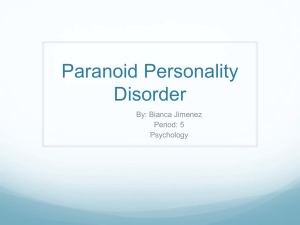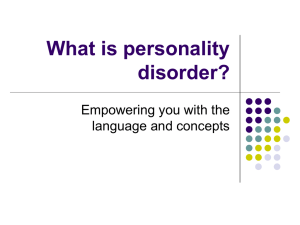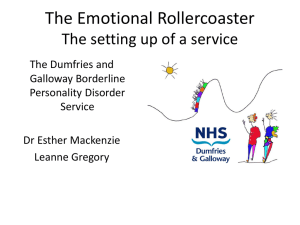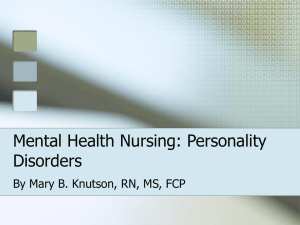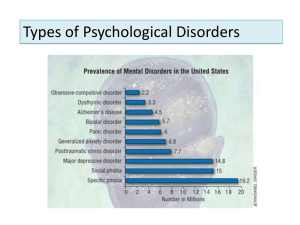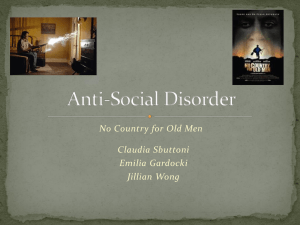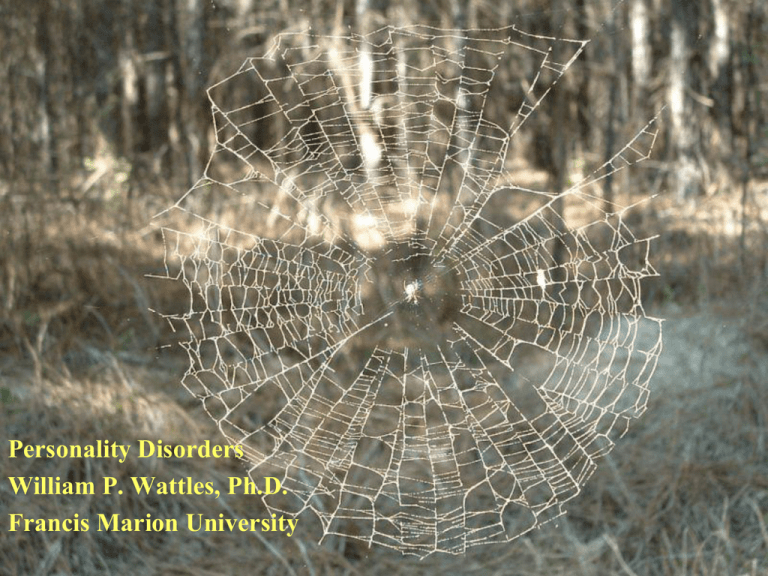
Personality Disorders
William P. Wattles, Ph.D.
Francis Marion University
1
Personality Disorders are generalized, inflexible
patterns of inner experience and behavior of
long-standing.
2
Personality Disorders are long-term,
maladaptive patterns of perception, emotional
regulation, anxiety, and impulse control.
3
Personality
• 1.The enduring pattern
of inner experiences
and outward behavior
that is unique to each
individual.
4
Personality Disorders
• Enduring pattern of inner experience
• Deviates markedly from the expectations of
the person’s society
• Pervasive and inflexible
• Onset in adolescence or early adulthood
• Is stable over time
• Leads to distress or impairment.
5
Personality Traits
• Enduring patterns of perceiving, relating to
and thinking about the environment and
oneself exhibited over a wide range of
social and personal contexts. Stable across:
– Time
– Place
– Situation
• Only disorders if maladaptive
6
Personality disorder
• Involves long-term functioning
–
–
–
–
difficult to assess in one interview
not organic, substance-induced or situational
must go back at least to early adulthood
may be ego-syntonic
7
PD’s frequently overlooked
• Client may express more concern with Axis I
Problems
• Personality styles often hidden and must be
inferred
• Can be difficult to distinguish between state
(clinical) elevations and trait (personality)
scales.
8
Cluster A
• Individuals appear odd
or eccentric
– Paranoid
– Schizoid
– Schizotypal
9
Cluster B
• Individuals appear
dramatic, emotional or
erratic
–
–
–
–
Antisocial
Borderline
Histrionic
Narcissistic
10
Cluster C
• Individuals appear
anxious or fearful
– Avoidant
– Dependent
– Obsessive-Compulsive
11
Paranoid Personality Disorder
• Pervasive distrust
and
suspiciousness of
others such that
their motives are
interpreted as
malevolent.
12
Paranoid Personality Disorder
• Four of:
– Suspects others
exploiting, harming or
deceiving
– preoccupied with
unjustified doubts of
loyalty of friends and
associates
– Reluctant to confide in
others
– Reads hidden
demeaning of
threatening meanings
into benign events
– persistently bears
grudges
– perceives attacks not
apparent to others
– recurrent suspicions
w/o cause regarding
fidelity of partner
13
Paranoid P.D.
• Overreact to minor
slights
• Hold grudges
• Constantly vigilant
• Quick to counterattack
14
Dichotomy
Normal
Paranoid
15
Points on Continuum
Paranoid
Traits
Normal
Gullible
Paranoid P. D.
Delusional
Disorder
Paranoid
Schizophrenic
16
Delusional Disorder
• Persecutory Type
• Central theme of being conspired against,
cheated, spied on, followed, poisoned
Maligned, harassed, or obstructed. May
engage in repeated attempts to get
satisfaction by appeal to courts and
government agencies
17
Delusions
• Erroneous beliefs that usually involve
misinterpretation of perceptions or
experiences.
– Vapor trails
• Delusions are deemed bizarre is they are
clearly implausible.
– Thought broadcasting
18
Delusional Disorder vs
Schizophrenia
• Bizarre versus nonbizarre delusions
• Bizarre if clearly implausible, not
understandable, not derived from ordinary
life experience.
• Nonbizarre involves thing that can occur in
real life: being followed, poisoned loved at
a distance, deceived by one’s spouse.
19
Schizophrenia
• Paranoid type
• Preoccupation with prominent delusions or
hallucinations
20
Schizoid Personality Disorder
• Pervasive pattern of
detachment from
social relationships
and a restricted range
of expression of
emotions.
21
Schizoid Personality Disorder
• Four of:
– neither desires nor
enjoys close
relationships
– Usually chooses
solitary activities
– Has little interest in sex
with another person
– Take pleasure in few if
any activities.
– Lacks close friend or
confidants
– appears indifferent to
praise or criticism
– shows emotional
coldness and flat affect
22
Schizotypal Personality Disorder
• Pervasive pattern of
social and
interpersonal deficits
marked by acute
discomfort with close
relationships as well as
by cognitive or
perceptual distortions
and eccentricities of
behavior.
23
Schizotypal Personality Disorder
• Five of:
– Ideas of reference
– odd beliefs
– unusual perceptual
experiences
– odd thinking and
speech
– suspiciousness or
paranoid ideation
– Inappropriate or
constricted affect
– odd behavior or
appearance
– lack of close friends or
confidants
– excessive social
anxiety based on
paranoid ideation
24
Antisocial Personality Disorder
• The essential feature is
a pervasive pattern of
disregard for the
violation of the rights
of others.
• Since age 15
• Sociopathy,
psychopathy
25
Antisocial Personality Disorder
– Failure to conform to
social norms
– deceitfulness, lying
aliases conning.
– Impulsivity and failure
to plan ahead
– irritability and
aggressiveness
– reckless disregard for
the safety of self and
others
– consistent
irresponsibility
– lack of remorse
26
Borderline Personality Disorder
• Pervasive pattern of
instability of
interpersonal
relationships, selfimage, and affects.
Marked impulsivity
• KM
27
Borderline Personality Disorder
– Frantic efforts to avoid
abandonment
– unstable and intense
relationships
– identity disturbance
– impulsivity: sex,
substance abuse,
reckless driving, binge
eating.
– Recent suicidal
behavior or threats
– affective instability
– chronic feelings of
emptiness
28
Histrionic Personality Disorder
• Pervasive Pattern of
excessive emotionality
and attention-seeking
behavior.
29
Histrionic Personality Disorder
– Uncomfortable if not
the center of attention.
– Inappropriate sexually
seductive or
provocative behavior.
– Rapidly shifting and
shallow emotions
– Uses physical
appearance to draw
attention.
– Speech is excessively
impressionistic and
lacking in detail
– Self-dramatization,
theatricality and
exaggerated expression
of emotion
– Suggestible
– Considers shallow
relationships intimate
30
Narcissistic Personality Disorder
• Pervasive pattern of
grandiosity, need for
admiration and lack of
empathy that begins
by early adulthood
31
Narcissistic Personality Disorder
– Grandiose sense of
self-importance
– Preoccupied with
fantasies of unlimited
success
– Believes he or she is
special
– requires excessive
admiration
– Sense of entitlement
– interpersonally
exploitative
– lacks empathy
– envious
– arrogant behavior and
attitudes
32
Narcissistic Personality Disorder
• Baughman article
• Sense of entitlement
• Lack of empathy or
conscience
• No lack of intelligence
• No lack of social skills
33
Uconn President
• …spending in hard times. There was the
$170,000 inauguration with regal fireworks,
the half-million-dollar office renovation, the
decision to have the state pay $49,000 in
rent on a house near campus rather than live
in the recently restored presidential mansion
(the reason cited was health issues related to
mold), and the $3,500 for six life-size
cutouts of him around campus.”
34
Avoidant Personality Disorder
• Pervasive pattern of
social inhibition,
feelings of inadequacy
and hypersensitivity to
negative evaluation.
35
Avoidant Personality Disorder
– Avoids jobs with social
contact or evaluation
– Unwilling to get
involved unless sure of
being liked
– Restraint in intimate
relationships
– Preoccupied with being
criticized or rejected
– Inhibited in new
situations due to
inadequacy
– view self as socially
inept
– reluctant to take risks
36
Dependent Personality Disorder
• Pervasive need to be
taken care of that leads
to submissive and
clinging behavior and
fears of separation.
37
Dependent Personality Disorder
– Difficulty making
decisions
– Needs other to take
responsibility for life
– Difficulty expressing
disagreement
– Problems with
initiative
– Excessive need for
nurturing
– Feels uncomfortable or
helpless alone
– Urgently seeks new
relationship when one
ends.
– Fears of being left to
care for self
38
Obsessive-Compulsive
Personality Disorder
• Preoccupation with
orderliness,
perfectionism and
mental and
interpersonal control.
39
40
Obsessive-Compulsive
Personality Disorder
– Preoccupied with
details, rules, lists,
order.
– Perfectionism that
interferes with task
– Excessively devoted to
work and productivity
– Rigid and stubborn
– Overconscientious
about matters of
morality, ethics or
values.
– Unable to discard
worthless objects
– Reluctant to delegate
– Miserly
41
Millon Clinical Multiaxial Inventory
MCMI-III
•
•
•
•
•
Standardized
Self-report
Adults
8th grade reading level
Focus on Personality Disorders
42
Millon Clinical Multiaxial Inventory
MCMI-III
• 175 items
• 28 Scales
• Closely aligned with Millon’s theory and
DSM-IV
43
MCMI-III
• Can be used instead of or in addition to
MMPI.
44
Theoretical Considerations
• Millon’s Theory
• Core Principle Polarities of:
– Pleasure-pain
– Active-passive
– Self-other
45
Interpretation
• BR base rate scores
– Used instead of T scores and norm-referencing.
– Distribution of scores varies from one
personality scale to the next.
– MCMI uses criterion referencing rather than
norm referencing.
– Base rate or prevalence of disorder in the
psychiatric population
46
BR scores
• For clinical scales:
– BR 75 indicates presence of a trait
– BR 85 indicates presence of a disorder
47
1. Interpret Profile Validity
• Validity Scale-3 items, 1 is sign of absurd answer
• Disclosure Index- below 34 indicates defensive
unwillingness to disclose.
• Desirability Index –measure of defensive
responding. Scores above BR 75 suggest claims of
unusual moral, attractive stable organized.
• Debasement index-the extent to which a client
describes themselves in negative terms. Above BR
85 bad profile and/or cry for help.
48
2. Interpret Personality Disorder
scales
• The primary focus for diagnosis is on the
Severe Personality Disorders.
– Unless elevations on others were high
compared to SPD
• Other personality pattern scales used to
elaborate on Severe Personality Disorder
Scale.
49
3. Interpret Clinical Syndrome
Scales
• Precedence given to elevations on Severe
Clinical Syndrome scales
• All can be elevated
50
Schizoid Scale 1
• Little or no interest in other people
51
Avoidant Scale 2A
• A desire to be with other people that is
blocked by an intense fear of being rejected
or humiliated.
52
Depressive Scale 2B
• Clients perceive themselves as worthless,
vulnerable, inadequate, unsuccessful, and
guilty. The frequently engage in selfcriticism and frame events in a defeatist
manner.
53
Dependent Scale 3
• They feel incapable and incompetent of
functioning independently. They quickly
form alliances and give up responsibility for
decisions. See themselves as placating,
insecure, passive and immature.
54
Histrionic Scale 4
• Histrionic persons are dramatic, colorful
and emotional. Tolerance for boredom is
low and they constantly seek novel
situations.
• Elevations of Histrionic are associated with
an above average number of positive life
events, low levels of distress and good
social adjustment.
55
Narcissistic Scale 5
• Exaggerated sense of self-importance and
competence.
56
Antisocial Scale 6A
• Competitiveness along with impulsive
acting-out of anti-social feelings.
Provocative, violent, vicious, self-centered,
dominant, dishonest, brutal an devious.
57
Aggressive Scale 6B
• Competitive, energetic, hard-headed,
authoritarian and socially intolerant.
Predisposed toward aggressive outburst
with little sensitivity.
58
Compulsive Scale 7
• Conformity, discipline, self-restraint,
formality. Strictly adhere to social norms.
Conscientious, well prepared, reghteous,
and meticulous.
59
Passive-Aggressive Scale 8A
• Passive compliance combined with
resentment and opposition.
60
Self-defeating 8B
• Present themselves as inferior,
nonindulgent, self-effacing, insecure. They
do not deserve pleasure.
61
Schizotypal Scale S
• Eccentricity, disorganization and social
isolation.
62
Bordeline Scale C
• Instability and unpredictability of mood and
behavior.
63
Paranoid Scale P
• Suspicious and defensive
64
Anxiety Scale A
• Tension, difficulty relaxing, indecisiveness,
and apprehension.
65
Somatoform Scale H
• Somatic complaints in the for of generalized
pain, fatigue, multiple vague complaints,
preoccupation with health problems.
66
Bipolar: Manic Scale N
• Moods swings that range from elation to
depression.
67
Dysthymia Scale D
• Sadness, pessimism
• hopelessness, apathy, low self-esteem, guilt
68
Alcohol Dependence Scale B
• A history of problem drinking.
69
Drug Dependence Scale T
• Recurring difficulties with drug abuse
70
Posttraumatic Distress Disorder
Scale R
• Extreme experience leading to fear,
helplessness and arousal.
71
Thought Disorder SS
• Inconsistent, bizarre, fragmented and
disorganized thoughts.
72
Major Depression Scale CC
• Severe depression-difficulty with effective
daily living.
73
Delusional Disorder PP
• Irrational but interconnected delusions,
persecutory thoughts and grandiosity
74
MCMI
• Commendable and innovative
• Generally a well-constructed psychometric
instrument
• Test-retest reliabilities moderate to high
• Factor analysis generally supports
organization of scales.
75
MCMI problems
• No “gold standard” or benchmark to
validate scale.
• Low interdiagnostician agreement
• May over diagnose and over pathologize
76
MCMI problems
• “Our ability to describe different personality
disorders has outstripped out ability to
diagnose them accurately in real-world
clinical settings.”
77
MCMI
• Axis 1 State
• Axis 2 Trait
• MCMI frequently revised to keep it
consistent with the DSM
• Should be used only with clinical
populations
78
The End
79

